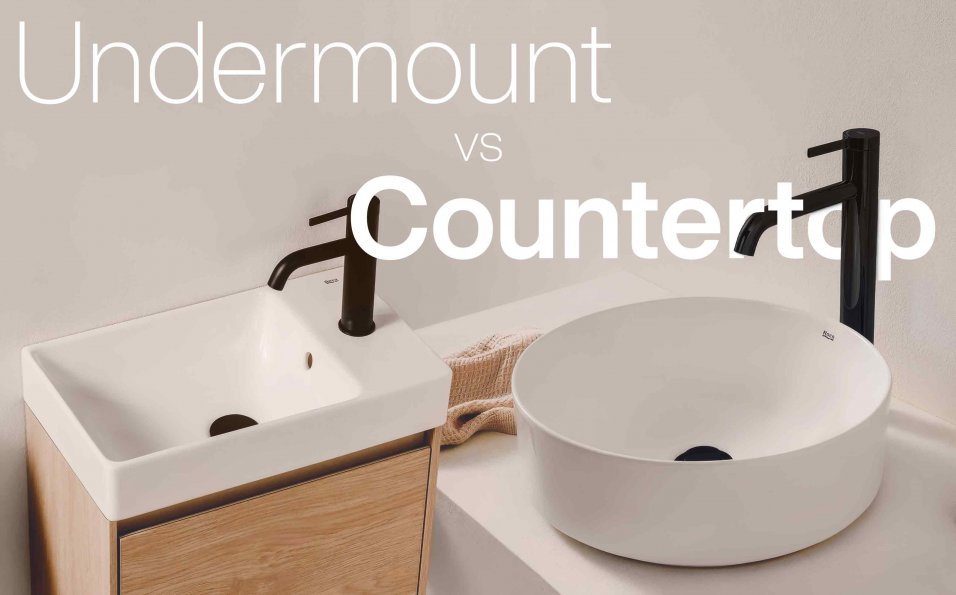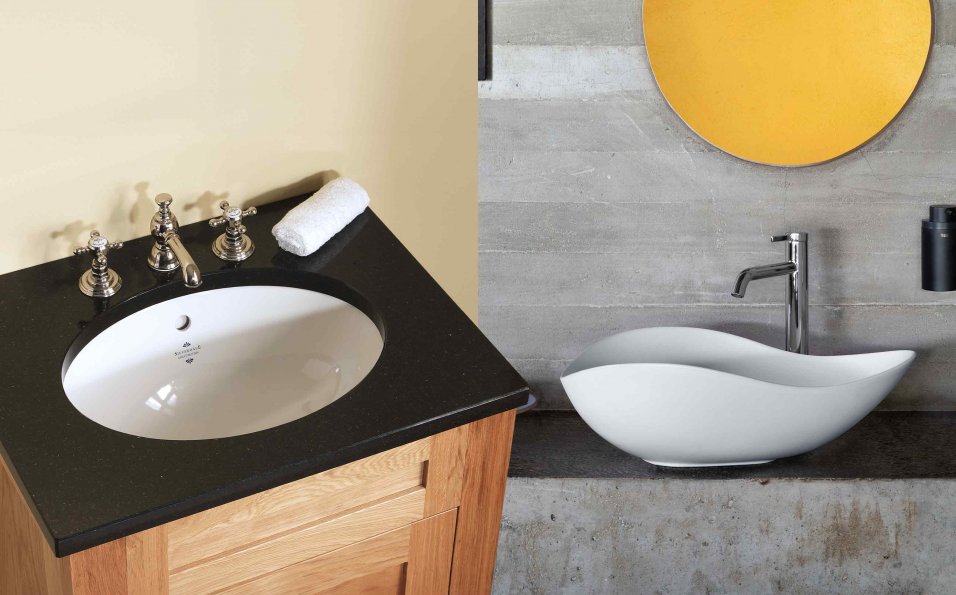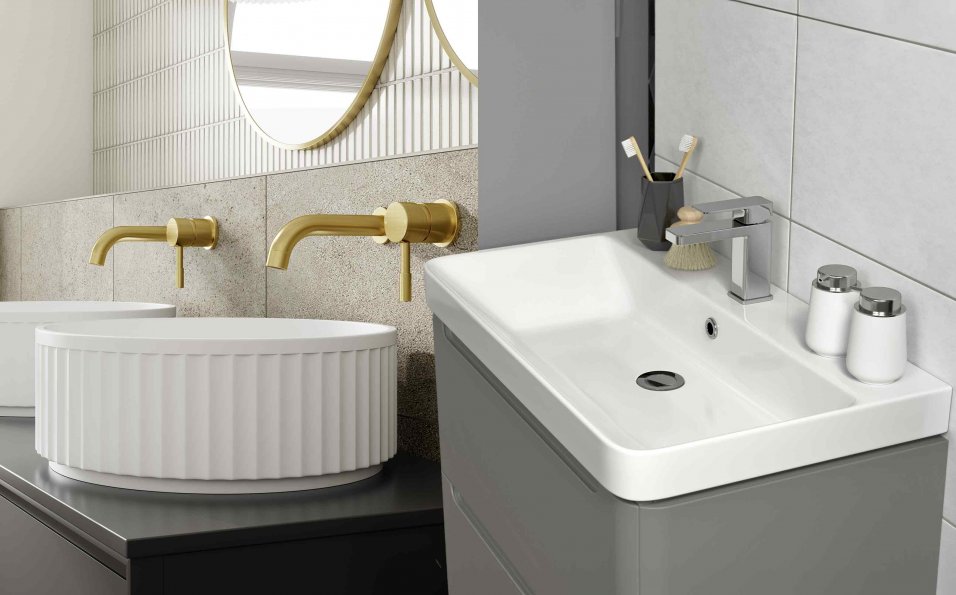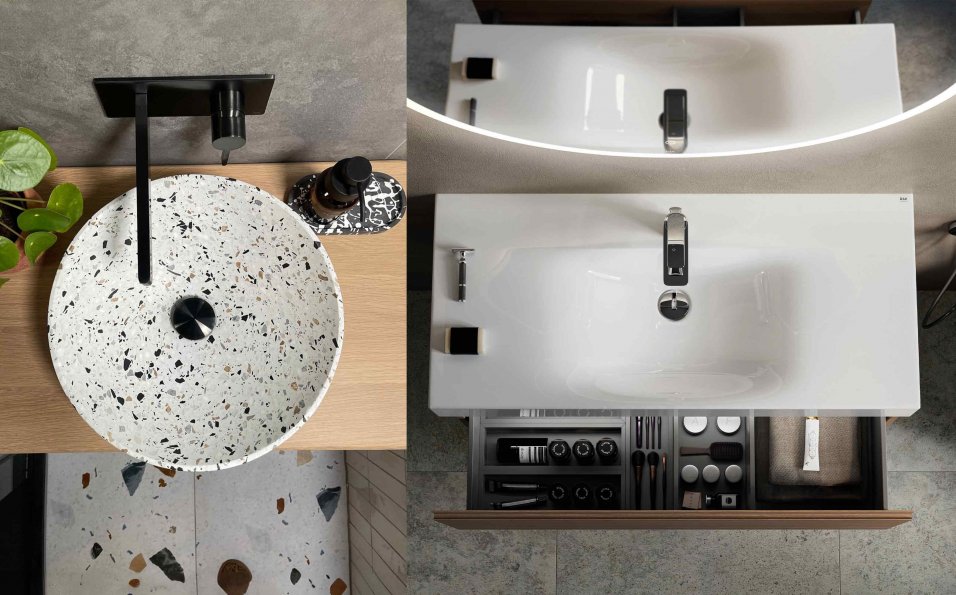| Tags | walk-in bath bath easy riser montana priya tray sizes anti-slip shower tray sizes shower tray freestanding baths geberit aquaclean aquaclean carron corner bath carron baths show all posts |
Undermount vs. Countertop Sinks: Which is Right for Your Bathroom Vanity?
When designing your bathroom vanity, the sink you choose can have a significant impact on the overall look and functionality of your bathroom. The sink, also known as a basin, needs to complement your vanity unit, fit seamlessly with your countertop, and align with your style preferences. With a myriad of options available on the market, it's essential to understand the differences between the two most popular choices: undermount sinks and countertop sinks. By the end of this article, you'll have a clearer understanding of which type of sink is the best fit for your bathroom vanity.
Understanding the Basics
Before we delve into the pros and cons of undermount and countertop sinks, let's first establish a solid foundation by understanding the basic characteristics and installation processes of each type.
What is an Undermount Sink?
An undermount sink, as the name suggests, is a basin that is installed beneath the countertop, creating a seamless and streamlined look. This type of sink is designed to be mounted directly to the countertop's underside, with the countertop's edge extending slightly over the sink's rim.
One of the main advantages of undermount sinks is their sleek and modern appearance, as they create an uninterrupted surface from the countertop to the sink. This not only enhances the visual appeal of your bathroom vanity but also makes cleaning and maintenance a breeze, as there are no exposed edges or lips where dirt and grime can accumulate.
When it comes to installation, undermount sinks require a bit more precision and planning compared to countertop sinks. The countertop must be cut to the exact dimensions of the sink, and the sink is then secured to the underside of the countertop using heavy-duty clips and a special adhesive. Because of the nature of the installation process, undermount sinks are typically compatible with solid surface countertops such as granite, quartz, or concrete, as these materials provide the necessary strength and stability to support the sink's weight.
What is a Countertop Sink?
Countertop sinks, also known as drop-in basins, are the more traditional option for bathroom vanities. As the name implies, these sinks are designed to be mounted on top of the countertop, with the rim of the sink resting on the surface of the counter.
One of the primary benefits of countertop sinks is their ease of installation. The countertop is cut to fit the sink's size, and then the sink is simply dropped into place and secured with a bead of silicone caulk around the perimeter. This straightforward installation process makes countertop sinks a popular choice for DIY enthusiasts and those looking to save on professional installation costs.
Countertop sinks are also compatible with a wider range of countertop materials, including laminate, tile, and wood, in addition to solid surface options. This versatility makes them a suitable choice for a variety of bathroom styles and budgets.
However, one potential drawback of countertop sinks is the presence of a visible rim that sits on top of the countertop. This rim can collect dirt and require additional cleaning effort to maintain a hygienic and attractive appearance. Additionally, the exposed edge of the sink can slightly disrupt the smooth, continuous flow of the countertop, which may be less appealing to those seeking a more modern and minimalist look.
Aesthetic and Design Implications
When choosing between an undermount and countertop sink for your bathroom vanity, it's essential to consider the aesthetic impact each option will have on your overall design. Let's explore the visual appeal and customisation options available for both types of sinks.
Visual Appeal
One of the most striking differences between undermount and countertop sinks is their visual appearance. Undermount sinks offer a sleek, seamless look that blends effortlessly with the countertop, creating an uninterrupted surface that exudes modern sophistication. This streamlined design is particularly well-suited for contemporary and minimalist bathroom styles, where clean lines and simplicity are key.
In contrast, countertop sinks feature a pronounced rim that sits on top of the countertop, creating a visible border around the sink. This design element can add a touch of traditional charm to your bathroom vanity, making it an excellent choice for those who prefer a more classic or ornate aesthetic. The exposed rim can also serve as a decorative feature, with some countertop sinks offering intricate detailing or bold colours to make a statement in your bathroom.
Ultimately, the visual appeal of undermount and countertop sinks comes down to personal preference and the overall style you are aiming to achieve in your bathroom. Consider the existing decor and design elements in your space, and choose the sink type that best complements and enhances your desired aesthetic.
Material Choices and Customisation Options
Both undermount and countertop sinks are available in a wide range of materials, each with its own unique characteristics and benefits. Some of the most common materials include:
Ceramic: A classic choice that is durable, easy to clean, and available in a variety of colours and finishes.
Stainless Steel: A modern and sleek option that is highly resistant to stains and scratches, making it an ideal choice for busy bathrooms.
Composite: A blend of natural materials and resins that offers a wide range of colours and patterns, as well as excellent durability and resistance to chips and cracks.
Natural Stone: A luxurious option that includes materials such as granite, marble, and travertine, each with its own distinct veining and colouration.
When it comes to customisation options, both undermount and countertop sinks offer a range of possibilities. Undermount sinks can be custom-made to fit the exact dimensions of your countertop, allowing for a truly seamless integration. Additionally, some manufacturers offer undermount sinks with unique shapes, such as square or oval, to further personalise your bathroom vanity.
Countertop sinks also provide customisation opportunities, particularly in terms of the rim design. From simple and understated to ornate and decorative, the rim of a countertop sink can be tailored to suit your personal style. Some countertop sinks even feature intricate patterns or embellishments on the rim, adding a touch of artistry to your bathroom vanity.
By exploring the various material choices and customisation options available for both undermount and countertop sinks, you can create a bathroom vanity that truly reflects your personal taste and complements your overall design vision.
Practical Considerations
While aesthetics play a significant role in choosing between an undermount and countertop sink, it's equally important to consider the practical aspects of each option. Let's examine how these sink types differ in terms of space, functionality, cleaning, and maintenance.
Space and Functionality
The way in which undermount and countertop sinks are installed can have a direct impact on the amount of usable counter space in your bathroom vanity. Undermount sinks, with their seamless design, allow for a slightly larger countertop surface area as the sink is mounted beneath the counter. This can be particularly beneficial for smaller vanities where every inch of counter space counts.
On the other hand, countertop sinks sit on top of the countertop, which can slightly reduce the amount of usable surface area. However, this difference is often minimal and may not be a significant concern for larger vanities or those with ample counter space.
Cleaning and Maintenance
One of the most significant practical considerations when choosing between an undermount and a countertop sink is the ease of cleaning and maintenance. Undermount
Installation Complexity and Cost
When deciding between an undermount and a countertop sink for your bathroom vanity, it's crucial to consider the installation process and the associated costs. Let's take a closer look at the complexity of installation and the financial implications of each option.
Installation Process
The installation process for undermount and countertop sinks differs significantly, which can impact your decision based on your DIY skills or budget for professional installation.
Undermount sinks require a more complex installation process, as they are mounted beneath the countertop. This process involves precisely cutting the countertop material to accommodate the sink, ensuring a perfect fit. The sink is then secured to the underside of the countertop using heavy-duty clips and a strong adhesive. Due to the precision required and the need to work with the countertop material, it is often recommended to hire a professional installer for undermount sinks, especially if you are working with delicate or expensive countertop materials like granite or quartz.
In contrast, countertop sinks offer a more straightforward installation process. The countertop is cut to fit the sink, and the sink is then simply dropped into place and secured with silicone caulk around the perimeter. This process is more forgiving and can often be completed by a confident DIY enthusiast, saving on professional installation costs.
Cost Analysis
The cost of installing an undermount or countertop sink can vary significantly depending on several factors, such as the material of the sink and countertop, the size of the vanity, and the complexity of the installation.
In general, undermount sinks tend to be more expensive than countertop sinks due to their sleek, seamless design and the need for precise installation. The cost of the sink itself can range from £100 to £1,000 or more, depending on the material and size. Additionally, professional installation for an undermount sink can add several hundred pounds to the total cost, as it requires specialised skills and tools.
Countertop sinks, on the other hand, are often more budget-friendly. The sinks themselves are typically less expensive, ranging from £50 to £500, depending on the material and size. Furthermore, the simpler installation process means that you may be able to save on professional installation costs by opting for a countertop sink.
It's important to note that while the upfront costs of a countertop sink may be lower, the long-term maintenance costs can be higher due to the need to clean around the exposed rim on a regular basis. Undermount sinks, with their seamless design, are often easier to keep clean and hygienic over time.
When considering the cost of installing an undermount or countertop sink, it's essential to factor in not only the initial purchase and installation prices but also the potential long-term maintenance costs. By weighing these factors against your budget and lifestyle, you can make an informed decision that best suits your needs and financial situation.
Conclusion
Choosing the right sink for your bathroom vanity is a decision that requires careful consideration of both aesthetic and practical considerations. Undermount and countertop sinks each offer unique benefits and drawbacks, and the best choice for your bathroom will depend on your personal style preferences, functional needs, and installation considerations.
Undermount sinks provide a sleek, seamless look that complements modern and minimalist bathroom designs, while countertop sinks offer a more traditional and versatile option that can work well with a variety of decor styles. When it comes to practical considerations, undermount sinks offer a slightly larger countertop surface area and easier cleaning, while countertop sinks provide a more straightforward installation process and potentially lower upfront costs.
Ultimately, the key to choosing the perfect sink for your bathroom vanity is to carefully weigh both the aesthetic and practical aspects, taking into account your personal preferences, lifestyle needs, and budget. By considering factors such as visual appeal, customisation options, space and functionality, cleaning and maintenance, and installation complexity and cost, you can make an informed decision that will result in a bathroom vanity that is both beautiful and functional.
Remember, your bathroom is a space where you begin and end each day, so it's essential to create an environment that not only looks great but also works well for your daily routine. By selecting the right sink for your vanity unit, you can ensure that your bathroom renovation or design project is a success, providing you with a space that you'll enjoy for years to come.








